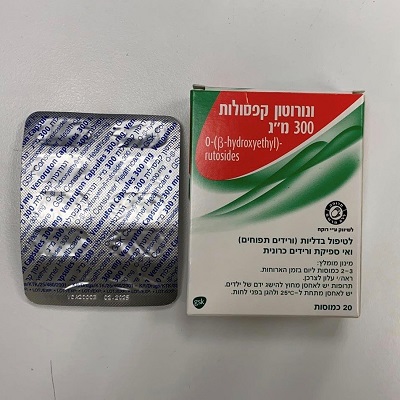Quest for the right Drug

ונורוטון קפסולות 300 מ"ג VENORUTON CAPSULES 300 MG (OXERUTINES)
תרופה במרשם
תרופה בסל
נרקוטיקה
ציטוטוקסיקה
צורת מתן:
פומי : PER OS
צורת מינון:
קפסולות : CAPSULES
עלון לרופא
מינוניםPosology התוויות
Indications תופעות לוואי
Adverse reactions התוויות נגד
Contraindications אינטראקציות
Interactions מינון יתר
Overdose הריון/הנקה
Pregnancy & Lactation אוכלוסיות מיוחדות
Special populations תכונות פרמקולוגיות
Pharmacological properties מידע רוקחי
Pharmaceutical particulars אזהרת שימוש
Special Warning עלון לרופא
Physicians Leaflet
Pharmacological properties : תכונות פרמקולוגיות
Pharmacodynamic Properties
5.1 Pharmacodynamic properties Pharmacotherapeutic group: Partially synthetic rutoside ATC code: C05CA54 The main pharmacological effect of oxerutines (HR) consists of a reduction in the capillary filtration rate for water and microvascular permeability for proteins. This has been shown both in various animal models and in clinical studies in chronic venous insufficiency (CVI), liver cirrhosis, idiopathic oedema and diabetic retinopathy. The effect on microvascular function may be explained by a reduction in interendothelial cell gaps, a modification of the interendothelial cell matrix and increased adhesion of endothelial cells to the microvascular wall. Furthermore, the results of numerous experimental models in vitro can be attributed to the interactions of HR with integral membrane components, which trigger changes not only in the barrier function of biological membranes, their fluidity and osmotic stability, but also in the activity of membrane-bound enzymes and active transport systems. Inhibition of red cell aggregation and improved red cell deformability, which may explain the observed improvement in microvascular flow and cutaneous oxygen levels, have also been shown in humans. These pharmacological effects lead to oedema reduction and associated symptoms in chronic venous insufficiency (CVI) and other indications characterised by increased local microvascular permeability. Furthermore, a significant protective effect has been demonstrated in membrane lesions caused by radioactive radiation. In addition, it has been shown that Venoruton does not reduce the radiation sensitivity of tumour tissue.
Pharmacokinetic Properties
5.2 Pharmacokinetic properties The pharmacokinetics of oxerutines has been studied in rats, mice, rabbits, dogs, rhesus monkeys and humans. Increasing substitution of the hydroxyl groups of the rutin base matrix by hydroxyethyl groups leads to increased water solubility, increased resistance of the molecule to bacterial degradation in the intestinal tract and a decrease in protein binding. The reversible protein binding of HR is about 30%. In rats, HR glycosides and glucuronides were found in the urine and bile (14-20% of the orally administered dose). Elimination is mainly via biliary (about 65%) and renal pathways and is complete after 24-48 hours. In addition, there is pronounced enterohepatic circulation. HR does not cross the blood/brain barrier. Following oral or intravenous administration, placental passage of HR is minimal; only traces were found in the foetus of rats and mice. Likewise, only traces were found in the milk of lactating rats. In humans, after oral administration of 14C-HR, peak plasma concentrations are reached after 1-9 hours. Measurable levels persist for about 120 hours. Its decline is biphasic: 3-6% of the administered radioactivity is excreted with the urine within 48 hours. The total elimination half-life ranges from 10-25 hours but is relatively constant intraindividually. Biliary elimination of HR and its glucuronidated metabolites has been confirmed in humans.

שימוש לפי פנקס קופ''ח כללית 1994
Varicose veins, hemorrhoids
תאריך הכללה מקורי בסל
01/01/1995
הגבלות
תרופה שאושרה לשימוש כללי בקופ'ח
מידע נוסף
